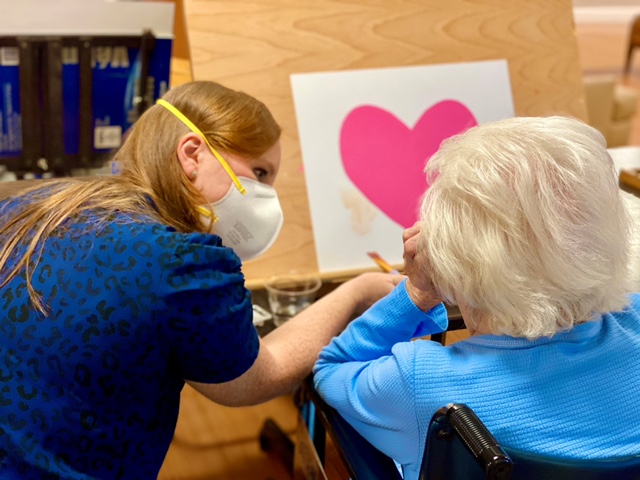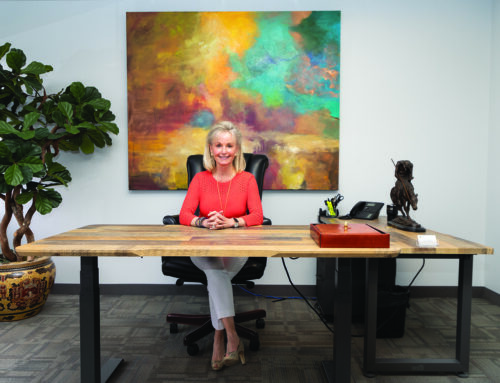
Photo courtesy of Juliette Fowler Communities.
THE ARTFUL AWAKENINGS PROGRAM at Juliette Fowler Communities stood out to Caroline Hardin because of her love for her grandparents.
Fowler residents who have dementia or Alzheimer’s disease are eligible for the program, which is held weekly. Volunteers from the Junior League of Dallas create art activities for anywhere from five to nine residents and then visit the East Dallas facility to walk the residents through the projects.
Hardin, a 28-year-old Dallas native who lives in the Knox/Henderson area, joined the Junior League about two years ago. Her mother is also a member, and she encouraged her to get involved to become more active in the community. She had moved back to Dallas from New York in 2019 and wanted to expand her network.
Artful Awakenings has been going on for about five years, with about 50 residents having participated, but Hardin became involved with the program in August 2021.
She was already familiar with Fowler, where she had volunteered growing up as a member of Northway Christian Church.
“I wanted to get involved with an organization that I was already kind of familiar with and would kind of tie back into my church’s network,” Hardin says.
The program would allow Hardin to spend time with seniors, an activity she thought she would enjoy because of the cherished memories hanging out with her own grandmother. Hardin also had experience working in the art industry, including at the Art Basel art fair and at Sotheby’s.
Art projects are planned so they’re easy for the residents to create, and Hardin says they’re mostly assembly. The teachers have an example displayed for the residents, and they often use templates. Earlier on, the plans were more complex, but the volunteers learned to make the instructions simple and straightforward.
One day, the volunteers helped the residents make bluebonnets. The stems were already drawn, and residents finger-painted the petals and added stickers.
“If it’s too abstract, then the residents get frustrated, and it defeats the purpose of the class, which is to calm them down and get everyone socializing during the sundowning hour,” Hardin says.
Her grandfather had dementia, and sometimes he would become grouchy, which wasn’t in line with his personality. That experience led her to have additional compassion for the Fowler residents, who occasionally make offensive remarks as a result of their cognitive impairment.
Nicole Gann, the president and CEO of Juliette Fowler Communities, has seen the residents’ quality of life improve through the program. Art helps them connect and engage with each other, Gann says, rather than withdrawing from society because of embarrassment or they realize they can’t communicate the same way.
“Connection cannot be underemphasized,” Gann says. “That is just the importance of it, is the connection and being together and accessing things that made them who they were and who they still are.”
Fowler is the only certified I’m Still Here Center for Excellence in Dementia Care in North Texas. The engagement-focused program connects people with memory loss through abilities that don’t diminish over time, and it is used to train caregivers, volunteers and residents’ families.
When the program was first implemented, there were concerns that some people would be frustrated or struggle to learn how to communicate with the residents, but Gann says the issues weren’t too much because everyone was so “like-minded.”
“I think that’s probably been the greatest gift that the programming has given to us — just a quicker, more refined way to help people be in community with the residents we serve,” Gann says.
The art helps residents to tell their stories and access memories, even if a particular instance isn’t visible to someone who views the finished product.
“They’re telling that story through the actual activity of the art, through the painting or through the crafting and through that conversation,” Gann says.
Sometimes colors in the art remind residents of gardens they used to grow, and then they’ll share stories related to that memory. Or maybe blue paint on the page reminds them of when they used to be a lifeguard or enjoyed swimming.
“You never know what color or what activity is going to spark that memory, but then it does, and it’s revealed to these volunteers and to our team through the simple act of being together,” Gann says. “But it’s another way that validates that they are still here.”






